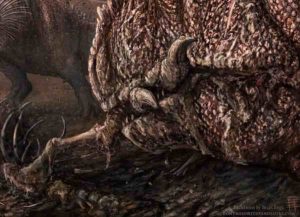
Top predator dinosaurs like the Allosaurus and Ceratosaurus devouring dinosaur remains isn’t all that surprising, but the smaller creatures feasting on dinosaur remains may just give us a more complete picture of what life was like at Mygatt-Moore Quarry outside Fruita, Colorado 152 million years ago. A new study out in PeerJ on Wednesday, July 15th, 2020 authored by Museums of Western Colorado’s Paleontologist Dr. Julia McHugh, looks at the insect species who feasted on decaying dinosaurs back in the Jurassic period.
Researchers Dr. Julia McHugh (Museums of Western Colorado, Colorado Mesa University), Dr. Stephanie K. Drumheller (University of Tennessee), Anja Riedel (Colorado Mesa University), and Miriam Kane (Colorado Mesa University) examined more than 2,300 fossil bones over a two-year study and found over 400 traces left by insects and snails, a surprisingly high number. The marks researchers found on the fossils also came from at least six different invertebrates. These findings are a huge step to understanding the long-lost paleo diversity, and paleo climate of the Jurassic period.
It also gave researchers a better understanding of just how stinky the Jurassic period was too. The abundance of traces meant that the dinosaur carcasses must have been unburied for a long time—5 months to 6 years or more according to this new study. “Large carcasses take a long time to decompose. The smell from a dead mouse in your basement is bad enough, but then imagine that mouse was a 65-foot long animal! The stench of rotting meat would have been a magnet for carrion insects and other scavengers,” Dr. McHugh explains.
Reference:
Julia B. McHugh et al, Decomposition of dinosaurian remains inferred by invertebrate traces on vertebrate bone reveal new insights into Late Jurassic ecology, decay, and climate in western Colorado, PeerJ (2020). DOI: 10.7717/peerj.9510
Note: The above post is reprinted from materials provided by PeerJ.










